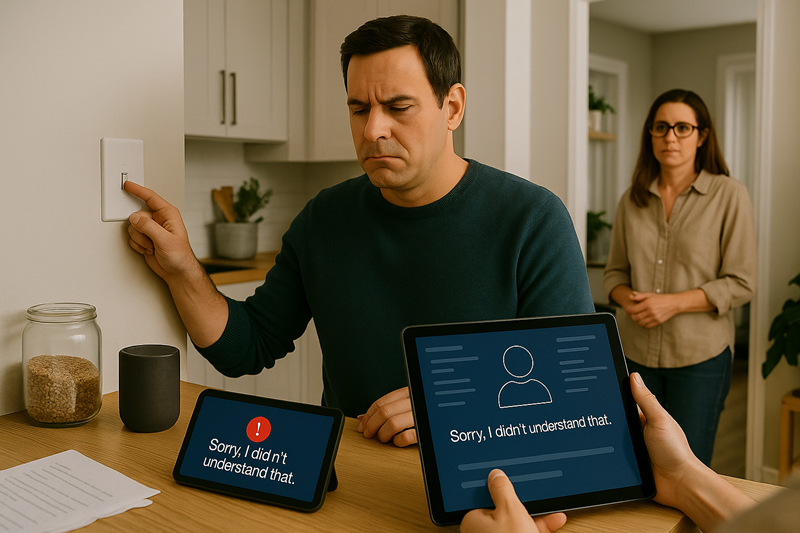Field Studies & Contextual Observation
Field studies and contextual observations are among the central qualitative methods of UX research. They serve the purpose of capturing actual usage situations directly in a natural context - for example at the workplace, in public spaces or at home. In contrast to laboratory or remote tests, this method allows an unbiased view of the interaction of user behavior, environmental influences and systemic framework conditions.
A typical example from practice: a UX team observes nursing staff using a mobile nursing documentation app directly on the ward. It is noticeable that entries are often not completed in full - not due to a lack of understanding, but because the professionals are interrupted by patients, colleagues or alarms. Such insights can hardly be gained through classic usability tests in the laboratory.
What Makes Field Studies Special?
Field studies are designed to be explorative. They often start with an open question - such as: “How do our customers use the app in their everyday lives?” - and approach the answer through observation, transcripts and conversations on site. In addition to behavior, external influences are also documented: Lighting conditions, noise levels, group dynamics, work routines or the use of aids.
Typical methods include:
- Shadowing: The researchers accompany a person over a longer period of time as they use a product or system.
- Contextual Inquiry: The person being observed is asked additional questions about the context of use, often in the form of brief queries (“Why are you clicking here?”), without interrupting the process.
- Visual documentation: Photos, sketches or video sequences supplement observation logs - if possible and approved under data protection law.
Practical Example: Smart Home Research
A development team is testing a new user interface for a smart home system. In interviews, users state that the controls are “actually easy”. However, field observations show a different picture: many commands are not recognized by voice control, which leads to frustration. Users then switch to manual switching on the device - a workaround behavior that was not noticed in the usability test. Only observation in a domestic context makes it clear how strongly ambient noise, Wi-Fi delays or daily routines influence use.

Advantages and Challenges
The greatest added value of field studies lies in their ecological validity - i.e. their proximity to the real usage situation. They not only uncover concrete problems, but also latent needs, implicit routines and creative workarounds that often remain hidden in structured tests. They also show what is not happening - for example, functions that are technically available but are never used.
At the same time, they are associated with challenges: access to the field (e.g. in safety-critical or medical environments) often requires approvals, data protection precautions and time flexibility. Observers must act sensitively and unobtrusively - without interfering in processes. There is also the risk of Observer Bias: what you see is always filtered through your own background.
When Does it Make Sense to Use it?
Field studies and contextual observations are particularly valuable in early phases of projects where the aim is to gain a deep understanding of real-life usage contexts. Typical application scenarios are:
- Elicitation of requirements for new systems or functions
- Validation of hypotheses from quantitative data
- Research into context-rich systems such as smart home technologies, industrial interfaces or mobile applications in the field
- Supplementing interviews, prototype tests or analytics in the mixed methods approach

Conclusion
Field studies and contextual observations open up access to the real use beyond the test environment. They make visible what users really do - not just what they say. Their findings help to further develop products and services in a grounded, realistic and user-centered way.
Frequently asked questions (FAQ)
What is a field study in UX research?
What does contextual observation mean?
What are the advantages of field studies?
What challenges are there?
When are field studies useful?
Which methods are included?
Field studies in UX research
These papers highlight classic and alternative methods of field research in usability evaluation, including ethnographic techniques, international contexts and practical studies 'in the wild'.
Field Studies
Basic text on field research - describes various forms such as ethnographic observation and contextual interviews. Provides practical instructions and strategic advice.
Baxter, K. (2015). Field studies. In Understanding Your Users (2nd ed.). Amsterdam: Morgan Kaufmann. https://doi.org/10.1016/B978-0-12-800232-2.00013-4
Alternative Methods for Field Usability Research
Comparison of three field methods: contextual questioning, ethnographic interviews and field usability tests. Helps with methodological selection.
Kantner, L., Sova, D. H., & Rosenbaum, S. (2003). Alternative methods for field usability research. In SIGDOC. https://doi.org/10.1145/944868.944883
Usability Evaluation of a Collaborative Design Software in the Wild
Demonstrates through a field study how contextual observations can more realistically evaluate the use of collaborative software.
Geszten, D., Hamornik, B. P., & Hercegfi, K. (2019). Usability evaluation of a collaborative design software in the wild. In IEEE CogInfoCom. https://doi.org/10.1109/COGINFOCOM47531.2019.9089963
Field Usability Testing: Method, Not Compromise
Introduces two models of field usability testing (ethnographic and structured) using concrete case studies.
Rosenbaum, S., & Kantner, L. (2007). Field usability testing: Method, not compromise. In IPCC. https://doi.org/10.1109/IPCC.2007.4464060
International Contextual Field Research
Discusses challenges and strategies for using contextual field studies internationally.
Siegel, D. A., & Dray, S. M. (2011). International contextual field research. In Usability and Internationalization. https://doi.org/10.1007/978-0-85729-304-6_5
Last modified: 16 November 2025
